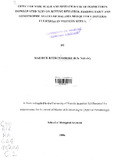| dc.description.abstract | This study investigated changes in the resting behaviour and feeding habit of An. gambiae s.l.
and An. funestus as a result of wide scale and sustained Insecticide Treated Nets (lTN s) use in western Kenya. A total of 20 compounds were randomly selected from an ITN implementation zone (Asembo) and an adjacent control area (Seme). Clay pots and Pit shelters were used for outdoor resting collections, Pyrethrum Spray Collections (PSC) for indoor resting collections and Colombian curtains (CC) for exiting mosquitoes. This study tested for the first time, the utility of Clay pots as low-cost, non-insecticide device for sampling outdoor resting fraction of anophelines .
A total of 3,848 resting An. gambiae s.l. were collected in the two areas; 1,510 indoors and 2,338
outdoors. More mosquitoes were collected indoors in Seme than Asembo while the reverse was true for outdoor collections. For indoor collections, the numbers were lower in Asembo compared to Seme but not significantly different for An. gambiae s.l. and An. funestus. For Clay pots, the numbers were significantly higher (p ≤ 0.05) for An. gambiae s.l. in Asembo compared to Seme. For Pit shelters, there was a significant difference (p ≤ 0.05) in the numbers of An. funestus between Asembo and Seme. Clay pots accounted for more than 80% of the outdoor collections, indicating their novelty as a sampling tool for outdoor resting An. gambiae s.l. mosquitoes. Clay pots performed as well as or better than the 3 other standard sampling methods, yielded males and females of both An. arabiensis and An. gambiae s.s ..
The Indoor resting densities of blood fed An. gambiae s.l. were 10.5% lower in Asembo. There was a higher Human biting index (HBI) in Seme (40.58%) compared to Asembo (36.84%). There was a significant difference in the numbers of early and late exit An. gambiae s.l. (p ≤ 0.001) and An. funestus (p ≤ 0.05) between Asembo and Seme, with higher proportions exiting early in Asembo. A higher proportion (64.9%1) of mosquitoes that exited early in Asembo were
-
I
nulliparous. There was a significant difference in the parity rate of An. gambiae s.l. (p ≤ 0.001)
-
I
and An. funestus (p ≤ 0.05) between Asembo (43.72%) and Seme (83.92%). This study also
shows a marked decrease of over 50% in sporozoite infection rates compared to pre-intervention,
-
I
for both species in Asembo. There was also a significant shift (p ≤ 0.001) in the An. gambiae s.l. sibling species composition in the ITN implementation area attributable to sustained ITN-use. There has been a marked effect on the resting and feeding habit of malaria vectors after eight years of sustained use of permethrin-impregnated bed-nets. | |

